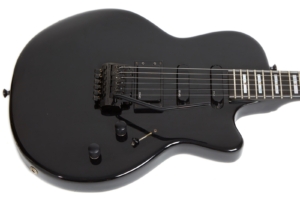
This 1986 Guild Bluesbird (which, though I call it a Setzer, doesn’t say Setzer anywhere on it) is a pretty unique instrument in the annals of Guild guitar history.
Let’s dig in and see why.
Introduction
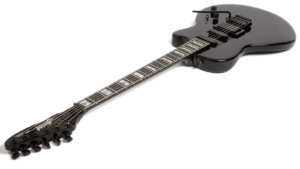
The catalogs describe the mid-’80s Bluesbird as “based on a traditional body design that Guild originally manufactured in the late 1950s”, going on to add that “The current glued-in-neck version was designed with Brian Setzer.” Another catalog states that it was designed “with modern guitarists in mind.”
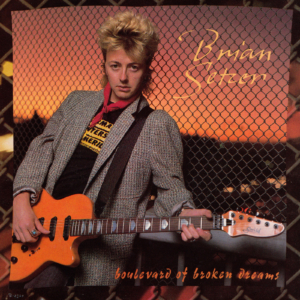
Though it’s hard to tell with printed colors, that guitar may be orange or more of an amber, but given Brian Setzer’s penchant for orange Gretsches, my guess would be that he went for orange. To be fair, he probably has a Gretsch Hot Rod in every color of the rainbow since they’re part of his signature line, but he’s certainly known for orange.
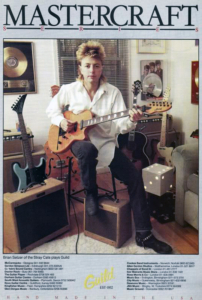
The very cool thing about the Mastercraft ad is that in addition to the more traditional Brian Setzer rig (Gretsch and a Fender Bassman) there is also a Guild S284 Aviator in the picture which is the blue guitar with the pointy headstock on the left of the frame, not to mention a tasty high-end Guild acoustic with the signature wedge inlays you’ll see on my Bluesbird.
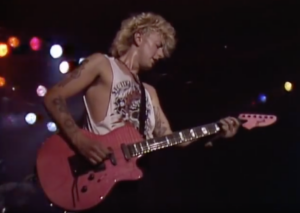
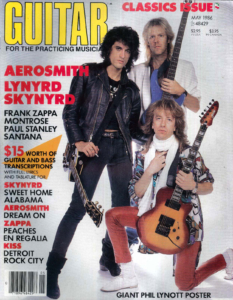
By 1987 the Bluesbird had gone through some changes. The 1987 catalog shows them with both a locking nut and Sperzel Trimlok tuning machines. The hardware had been upgraded to gold and the headstock had migrated from the “foot” shape seen on the previous examples to the “cake knife” shape seen on my Liberator Elite.
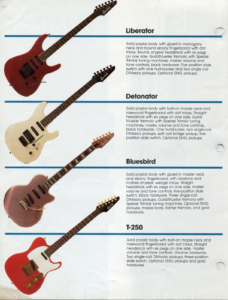
Before we go on I must once more thank Grot from The Guilds of Grot for providing some of the catalog pages shown here. Even with the ridiculous amount of time I spend trolling auction sites and online music stores, I just can’t seem to find good ’80s-era Guild catalogs and Kurt (Grot = Kurt) has been willing to share some high-def scans of what he has which is always appreciated considering the fact that I actually bought that Guitar for the Practicing Musician magazine with Aerosmith on the cover for a stupid price on eBay just because it has a Guild Bluesbird on the cover.
Finish
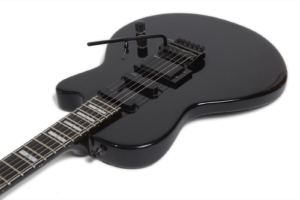
The finish is quite nice, though I’m not terrible fond of black guitars. They certainly do seem to find me though, and I’ve got more than my fair share of them.
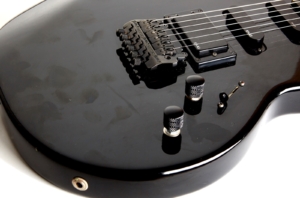
Fretboard and Neck
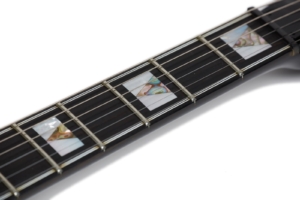
I love the inlays, but they almost seem out of place on this guitar which is otherwise kind of plain. They would probably look better on the flamed maple versions, but even then I think they belong on very high-end guitars like the Nightbird or Nightingale. Still, no complaints here and the fretboard is stunning.
This is a long-scale guitar with a scale length of 25 5/8″ and a nut that is halfway between 1 5/8″ and 1 11/16″ wide. It has a comfortable C shape carve that is neither super thin nor very fat.
The frets measure .05″ high by 0.11″ wide making them 6150 jumbos. The fretboard radius appears to be about 14″. The neck size, ebony board, high-end inlays and super-nice jumbo frets make this guitar a joy to play, and my guess is that’s the point as Brian Setzer’s involvement was reportedly to help make a guitar for the modern (circa 1986) guitarist.
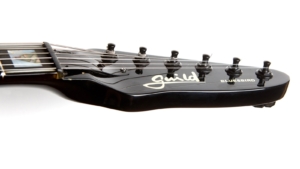
At some point in this guitar’s life, someone decided that locking nuts were too much of a pain and had it removed. They also blocked the Kahler so that it could not pull up, so I’m guessing it was just someone who hated double locking trems but otherwise liked the guitar. Thankfully it doesn’t appear that any permanent damage was done and the holes for the lock were not filled so after receiving a new one (kudos to Kahler for continuing to sell them!) and installing it the guitar is as good as new.
Build Quality
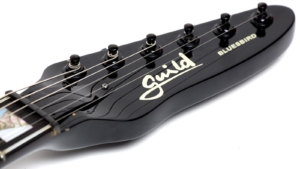
According to the catalog description, the necks on these guitars are either hard maple or flamed maple. The neck is glued in which I greatly prefer over bolt-on necks mostly because my only guitar for 20 years was a set-neck Guild.
This guitar weighs exactly seven pounds and is balanced quite well. It plays wonderfully either sitting or standing and has no appreciable movement when worn with a strap.
Pickups
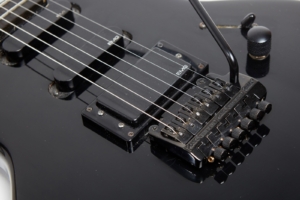
Since these all have ceramic magnets, they lean towards a more crisp trebly sound (think Telecaster more than Strat) but tend to be very high output, especially considering the fact that they’re all active. This make sense to me because at the point that this guitar was designed, Brian Setzer was seen playing a tele in the rain. Sure, it wasn’t a traditional Tele, but he was clearly fond of that brighter sound at the time as there was nothing but Teles in his band.
Electronics
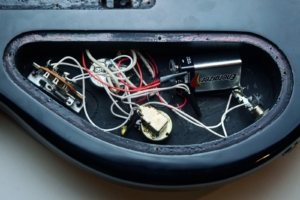
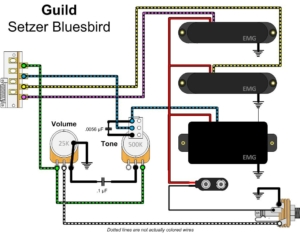
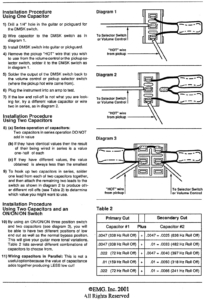
EMG does not seem to sell a DMSK solution currently (2017), but I did find a link to older ad copy that stated: The EMG-DMSK Dual-Mode Switch Kit® allows you to simulate a single-coil sound with any EMG humbucking pickup. It utilizes a capacitor in series with the pickup output to naturally roll-off the low frequencies. For even greater flexibility, the kit includes three optional capacitors that allow you to tailor the roll-off to your tastes. Activated with a single mini-toggle switch, the DMSK can be used much like a humbucking coil-tap switch without the hum associated with traditional coil-splitting. The DMSK also preserves the low-impedance output of the pickup
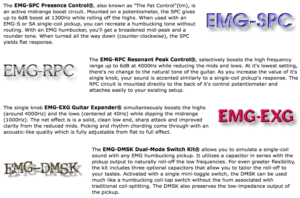
How well does it work? Well, at first I thought it was a coil split until I remembered that EMG 81s cannot be split, so it’s got that going for it. As I listened with a more critical ear I realized that I really do not like the tone from the bridge pickup in the “just like a single coil” position. To me it sounds like the very narrow-band effect used when trying to simulate someone talking over the phone. I will say, though, that it seems to work well in the bridge+middle position where it does seem to help to impart that Strat-like quack that we all love, and that alone makes it worthwhile in my book.
What I find funny about this control is that if Guild did indeed call this the fat switch, then that’s amusing because it sounds fat with the switch off. It’s actually a “thin out the tone to simulate a single coil” switch but I imagine the marketing department wouldn’t have approved that as a feature name.
Hardware
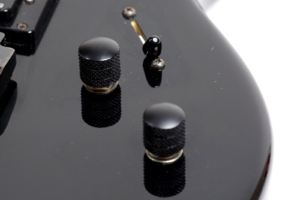
I don’t know if the strap pegs are original, but as it came to me it has strap locks on it. I think that any guitar being gigged should have strap-locks, so I have no complaints there.
This guitar has a blade switch and I’m not a fan of those, but with the number of options possible given three pickups there aren’t a lot of other ways to accomplish their selection. For example, Guild tried something different on the Liberator Elite with three three-way toggles but that was just maddeningly complex, so I think the blade switch solution is as good as it gets.
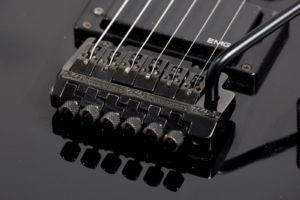
This is the first time I’ve been exposed to this bridge and from my limited experience with it I think I hate it. First, the good points: It’s got a replaceable blade system which allows the knife edges to be replaced should they wear. Of course, since this bridge was discontinued in 1990, you’ll never find those parts unless you buy another bridge because not even the excellent wammyparts.com website has the blades as of this writing. I’m sure at the time they thought it would be around forever.
It’s also nice that the fine tuners are out of the way which is my only complaint about the 2300 Pro Kahlers. Aside from that, this bridge is a mess. It’s poorly engineered, has some very strange very special parts and on this guitar sits a bit high for my tastes. The best way I could describe this bridge is that it behaves like a Floyd Rose in that it has all of the negatives and none of the positives of that other brand’s bridge.
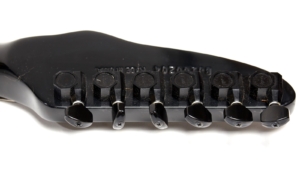
There is no pick guard on this guitar as the pickups are direct mounted to the top.
Sound
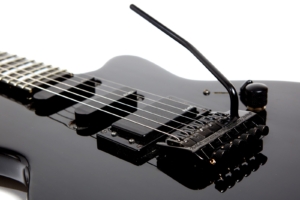
As I’ve written in other reviews, one of my problems with EMGs is that putting them into a guitar makes the guitar sounds like “a guitar with EMGs” versus something new. Still, remember that this guitar was designed and built in the ’80s when active pickups were new and exciting and were something almost everyone wanted. If this guitar was shaped like a Strat then it would be a Super-Strat, and that’s really what it behaves like even though the body is shaped more like a Les Paul which is why it’s called a Bluesbird.
ODS-100
7th Chords
Open Chords #1
Open Chords #2
D-Shape Chords
Barre Chords
JCM-800
A Barre Chords
D-Shape Chords
For each recording I cycle through the following pickup selection which encompases all possibilities given the electronics layout:
- Neck
- Neck + Middle
- Middle
- Middle + Bridge (push/pull in)
- Middle + Bridge (push/pull out)
- Bridge (push/pull in)
- Bridge (push/pull out)
Thus, each recording has seven examples of the same riff.
The guitar can produce some nice tones and can pull off that Strat vibe pretty convincingly, though purists will likely complain about the active pickups sounding “sterile”. It’s certainly a plus that the guitar can deliver seven different combinations (and obviously more with volume and tone tweaking), but I found a couple of them to be kind of odd such as the aforementioned nasally bridge pickup sound that occurs with the push/pull “fat” switch pulled out.
Playability
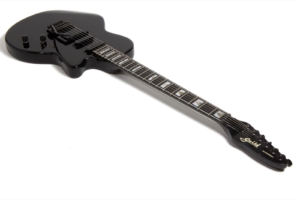
My only real beef with the guitar in terms of playability is the bridge. I found that it didn’t stay in tune very well even after replacing the locking nut and as a result I needed to adjust the fine tuners too much for my tastes. Additionally, I really dislike screw-in tremolo bars and this one drove me nuts just like all the others I’ve played.
With it’s jumbo frets it can take some getting used to if you’re used to vintage Guilds, but the same would be true with any super-Strat.
Conclusion
I like this guitar but I don’t love it. Well, not all of it. What I do love is the fretboard, neck, and especially the inlays. Everything else is pretty standard fare for a mid-’80s Guild electric except for the Kahler which I consider a step down from the 2300 Pro.
This guitar is cool because it’s unique, but I think it’s unique in a way that doesn’t solve any problems that I needed solving. The neck seems excessively ornate compared to the very simple and plain body. It plays fine, but I don’t walk away from playing this guitar thinking that I can’t wait to pick it up again. The tones it can produce are fairly versatile, but then that’s pretty much true of any HSS-equipped guitar.
The neck is the winner here. The fretboard, frets, and overall feeling of the neck is superb, and it puts the rest of the guitar to shame. That kind of makes the guitar a little odd for me because it’s got this top-end neck and board with an otherwise sort of boring and uninspiring body, but let’s be honest here – it’s a Les Paul shaped body with a high-end Strat-like long-scale neck and that’s sort of cool.
If you find one of these with a Kahler 2300 Pro or a Floyd Rose then I think you’d have a winner because though it’s not an inspiring work of art, the guitar still plays like the US Westerly-made Guild that it is; it just needs a better bridge. Oh, and if you do find one it will probably sell for less than a current Korean-made Newark Street Guild.
I think the best part of playing this guitar live would be after kicking ass on stage with it Guitar nerds would be falling all over themselves trying to figure out what the hell it is you’ve got in your hands, and I don’t know about you, but I kind of like that in a guitar.
Donate: PayPal Crypto:
ETH: 0x0AC57f8e0A49dc06Ed4f7926d169342ec4FCd461
Doge: DFWpLqMr6QF67t4wRzvTtNd8UDwjGTQBGs




Dear GAD
Thanks for your comment & explanations.
It was everything I wanted to know about the guitar.
Your comment on conclusion,
” I like this guitar but I don’t love it” is very honest phrase
which I seldom sees on the magazines.
Again, Thanks for your comments.
Sincerely Shiro Hirai
Very good description of this great guitar. I have a ’86 model with HSS configuration.
It is really a high end guitar with very versatile sounds. For example, i can’t play a song like le Freak on my les paul because of the woody tone but the guild can handle everything.
https://youtu.be/_9NJXU2Hj0c on this video you can hear the guild but the quality of the video is not good.
I don’t think i will ever sell this guitar but on the other hand i don’t use it to often.
Nice to learn more about this great underrated (compared to non-Selzer Bluesbirds) guitar. I have a rather nice orange model with twin P90s, originally twin humbuckers. pics of mine here https://www.thegearpage.net/board/index.php?threads/guild-buebird-80s-brian-setzer-model.1629259/
I have the 87 Bluesbird and I think your evaluation of this guitar is amazingly spot on. I can’t argue with anything you said about it. The neck is the best part of the guitar. I will never sell it. I have run into people who I haven’t seen in 20 years that have played this guitar when they stopped by our band practice, and one of the first things they ask me is, do you still have that guitar?
I own six of these guitars. Maybe the largest collection?
(2) black
(1) sunburst
(1) white
(1) amber
(1) red
They are all setup slightly differently. If interested, can submit the specs. The two black guitars have been played on the road for many years with custom mods and still look great and sound awesome. The white one is all original for the studio. The others are collectorsand mint.
Nice! Would love to see pics!
incredible coincidence… my initials are also JD. And I agree, you probably have the largest collection. From what I’ve read, 216 were built in total. I had four. I am down to two, one of them a prototype that I purchased directly from the then-president of Guild in 1985 when he brought it into the music store where I worked to show it off. That one was orange/pink on flame maple… I always describe it as “dirty flamingo”. Triple EMG SAs (I think). My other is a beautiful light tobacco sunburst over flame maple, a production model. A couple years ago I sold another maple (dark blue stain) and recently sold a solid black one.